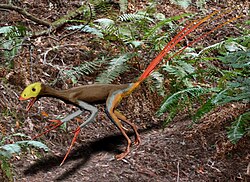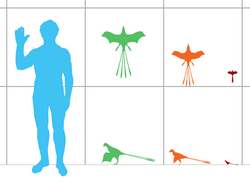Epidexipteryx
Epidexipteryx ('display feather') is a genus of small maniraptoran dinosaurs, known from one fossil specimen in Beijing. Epidexipteryx is the earliest known example of ornamental feathers in the fossil record.[1] It is a small maniraptoran dinosaur from the Middle or Upper Jurassic age Daohugou Beds of Inner Mongolia, China (perhaps 160 to 168 million years ago).[2]
| Epidexipteryx Temporal range: ? Upper Jurassic
| |
|---|---|

| |
| Scientific classification | |
| Kingdom: | |
| Class: | |
| Superorder: | |
| Order: | |
| Suborder: | |
| (unranked): | |
| Genus: | Epidexipteryx Zhang et al. 2008
|
Structure
It is known from a well preserved partial skeleton that includes four long feathers on the tail, composed of a central rachis and vanes. However, unlike in modern-style tail feathers, the vanes were not branched but made up of a single ribbon-like sheet. Epidexipteryx also preserved a covering of simpler body feathers. They are unique in that some appear to arise from a "membranous structure".[2]
In all, the skeleton of Epidexipteryx hui measures 25 centimeters (10 inches) in length (44.5 cm or 17.5 in including the incomplete tail feathers),[3] and the authors estimated a weight of 164 grams, smaller than most other early dinobirds.[2]
The skull of Epidexipteryx is also unique in a number of features. It had teeth only in the front of the jaws, with unusually long front teeth angled forward, a feature only seen in Masiakasaurus among other theropods. The tail of Epidexipteryx bore unusual vertebrae towards the tip which resembled the feather-anchoring pygostyle of modern birds and some oviraptors.[2]
Despite its close relationship to avialan birds, Epidexipteryx appears to have lacked wing feathers, and so it could not fly. Zhang et al. suggest that unless Epidexipteryx evolved from flying ancestors and subsequently lost its wings, this may indicate that advanced display feathers on the tail may have predated flying or gliding flight.[2]
Dating
There is uncertainty about the age of the Daohugou Beds in which this fossil was found. Various papers have placed the fossils here anywhere from the Middle Jurassic (169 million years ago) to the Lower Cretaceous (122 ma).[4] The age of this formation has implications for the relationship between similar dinosaurs, as well as for the origin of birds in general. A Middle Jurassic age would mean that the bird-like dinosaurs in the Daohugou beds are older than the 'first bird', Archaeopteryx, which was late Jurassic in age. Until this question is decided, the significance of Epidexipteryx (and other early dinobirds from that area) is not clear.
Epidexipteryx Media
The scansoriopterygid genera Epidexipteryx (orange), Yi (green), and Scansoriopteryx (red) compared to a human in size
Life restoration showing the animal without arm membranes
References
- ↑ Morgan, James (2008-10-22). "New feathered dinosaur discovered". BBC. Retrieved 2009-07-02.
- ↑ 2.0 2.1 2.2 2.3 2.4 Zhang, Fucheng et al 2008. A bizarre Jurassic maniraptoran from China with elongate ribbon-like feathers. [1] Nature 455, 1105-1108. doi:10.1038/nature07447
- ↑ Zhang F. et al. 2008. A bizarre Jurassic maniraptoran from China with elongate ribbon-like feathers. Supplementary Information. Nature, 455: 46pp. doi: 10.1038/nature07447
- ↑ Ren D. et al. 2002. On the biostratigraphy of the Jurassic fossil beds at Daohugou near Ningcheng, Inner Mongolia. Geol. Bull. China 21, 584-591.
Other websites
- "New feathered dinosaur discovered". news.bbc.co.uk. Retrieved 14 July 2010.




